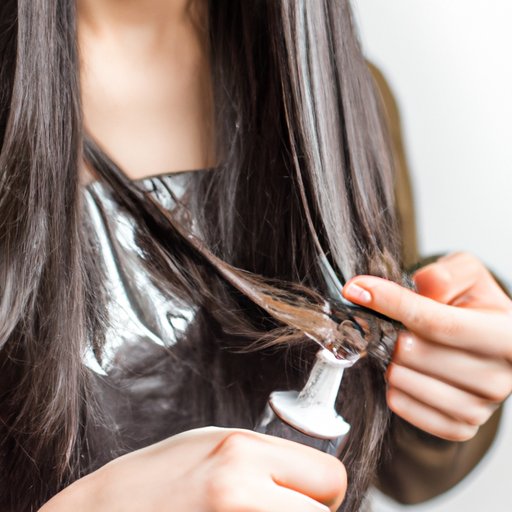Introduction
Are you looking to achieve a bold hair color but don’t want to pay a premium at a salon? Bleaching hair at home can be a cost-effective solution! However, the process can be intimidating for beginners. In this article, we provide a step-by-step guide to safely bleach hair at home. We also offer product recommendations, natural alternatives, precautions, and tips for achieving your desired look.
Step-By-Step Guide
Before bleaching your hair, make sure to gather all the necessary tools. You’ll need bleach powder, developer, gloves, a brush, clips, a mixing bowl, and a shower cap. Additionally, it’s essential to prepare your hair by washing it a day before to remove any build-up. Try not to condition your hair before bleaching, as it may affect the outcome.
Here’s a step-by-step guide to safely bleach hair at home:
1. Mix the bleach powder and developer according to the instructions and stir until smooth.
2. Part your hair into small sections and clip them up. Then, apply the bleach mixture to each section, starting at the ends and working upwards towards the roots.
3. Once you’ve covered all the sections, put on a shower cap to lock in the heat.
4. Check the color of your hair every 10-15 minutes, keeping in mind that bleach can turn hair yellow or orange before turning it blonde. Rinse the bleach out when it reaches your desired color.
5. Wash your hair with shampoo and conditioner to remove any excess products, and you’re done!
For best results, wait at least a week before dyeing your hair. This gives your hair the time it needs to recover from the bleaching process.
Product Reviews
There are numerous bleaching products available in the market, each with different types of hair they’re best suited for. Here are some of the popular ones:
1. Manic Panic Flash Lightning Bleach Kit: This product has a high lift formula, suitable for those with medium to dark hair. It’s vegan and contains hydrating ingredients to prevent hair damage.
2. L’Oreal Paris Super Blonde Creme Lightening Kit: This kit contains a conditioning formula to protect your hair while lifting its color. It’s best for those with light to medium brown hair.
3. Wella Blondor Multi-Blonde Powder Lightener: This powder lightener has been around for decades and is known to provide professional quality results. It’s suitable for all hair types, and the formula includes Tri-Lightening Complex to minimize hair damage.
DIY Natural Alternatives
If you’re hesitant about using commercial bleaches, some natural alternatives can help lighten your hair. Here are some items you can find in your kitchen:
1. Lemon Juice: Lemon juice is a natural lightener, and applying it to your hair before sunbathing can lighten it. Keep in mind that the acid in lemon juice can dry out your hair, so always use a hydrating conditioner afterward.
2. Honey: Honey contains peroxide, making it a natural bleaching agent. Mix honey with water and apply the mixture to your hair. Let it sit for a few hours before washing it off.
3. Chamomile Tea: Brew chamomile tea, let it cool, and apply it to your hair for a natural lightening effect.
Precautions
Before bleaching your hair, it’s essential to take necessary precautions. Always conduct a skin and hair allergy test to make sure you’re not allergic to any of the products. Also, perform a sensitivity test on your scalp to prevent any burning or discomfort. Lastly, do a strand test to check for hair damage and determine how long you need to leave the bleach in.
Bleaching Tips for Different Hair Types
Different types of hair require different methods for achieving the perfect bleached look. Here’s a general guide:
1. Fine or Thin Hair: Use a lower volume developer to prevent over-processing of the hair. Also, reduce the duration of the bleach sitting on the hair.
2. Coarse or Thick Hair: Use a higher volume developer to ensure all the hair fibers get treated. Leave the bleach on for a few extra minutes than necessary.
3. Natural Curls: Be extra cautious when applying bleach to curly hair. Keep the bleach away from the scalp and make sure to work gently through the curls.
Advantages and Disadvantages of Bleaching Hair at Home
Bleaching hair at home has its advantages and disadvantages. One obvious advantage is cost-effectiveness compared to a salon visit. However, there’s also a higher risk of hair damage when bleaching it yourself. You must take necessary precautions, properly care for your hair post-bleaching, and have a basic understanding of hair color theory.
Conclusion
Bleaching hair at home can be a fun, affordable way to achieve bold hair color. However, it’s crucial to take precautions and follow the right methods. We hope this guide has provided you with a better understanding of how to bleach hair at home safely. Share your experiences and let us know your favorite product recommendations in the comments section.
